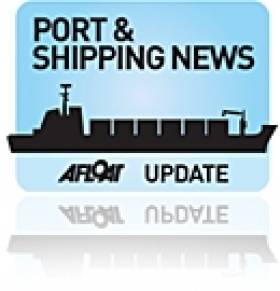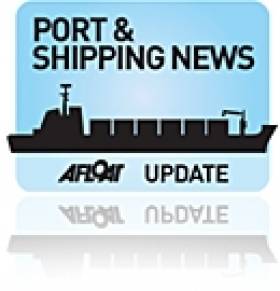Displaying items by tag: iShip Index
The iShip Index outlining trends within Ireland’s shipping industry grew by 5% in 2021, the Irish Maritime Development Office says.
The IMDO’s iShip Index is a quarterly weighted indicator that accounts for five separate market segments, representing the main maritime traffic sectors moving through ports in the Republic of Ireland.
These comprise unitised trade which includes lift-on/lift-off (LoLo) and roll-on/roll-of (RoRo), and bulk traffic which includes break bulk, dry bulk and liquid bulk.
The IMDO says 2021’s figure is the fastest rate of growth in the index since 2017, and represents a return to the volumes of freight handled in 2018 and 2019 after the suppressive effect of the COVID-19 on port traffic.
Just over 54 million tonnes of freight were handled at Irish ports in 2021, a 2.8 million-ton increase compared to 2020, the IMDO says.
In the dry bulk market, a 10% annual increase compared to 2020 was almost entirely driven by coal. This trend is reflected in port traffic volumes, as imports of coal through Shannon Foynes Port Company rose by over 1.2m tonnes.
In the liquid bulk market, growth of 7% was driven by oil, Ireland’s largest source of domestic energy. Imports of petroleum rose in all three of Ireland’s Tier 1 ports in 2021 as demand for domestic and aviation fuel rose in line with the lifting of COVID-19 restrictions.
Lastly, break bulk traffic across Irish ports rose significantly in 2021, increasing by 12%. This was driven by a return to construction activity in the domestic and international markets after severe restrictions within the sector throughout 2020.
In the unitised freight market, performance in 2021 was defined by two main characteristics. Firstly, 2021 recorded a surge in demand on direct services between the Republic of Ireland and mainland European ports, driven by the post-Brexit transfer of traffic away from the UK landbridge.
LoLo traffic, measured in Twenty-Foot Equivalent Units (TEUs), rose by 12% to 1.17m TEUs, the highest annual volume on record. RoRo traffic on direct routes grew by 94% to an unprecedented level of 383,000 RoRo units.
The second predominant trend that emerged in 2021 was the increase in RoRo traffic at Northern Ireland’s ports.
Through consultations with stakeholders and through detailed analysis of time series trends of RoRo traffic on the island of Ireland, the IMDO says it is clear that haulage companies based in Northern Ireland have transferred significant volumes of business away from RoRo services in ports in the Republic of Ireland.
The IMD suggests that this, along with the move away from the UK landbridge, explains the decline in RoRo traffic between Irish and UK ports in 2021. These volumes declined by 22% in 2021.
Overall RoRo traffic in the Republic of Ireland declined by 3% this year, offset by the surge in traffic on direct services. RoRo traffic in Northern Ireland grew by 12%.
In all, freight volumes through the Republic of Ireland recorded robust growth in 2021, and have returned to levels consistent with those before the COVID-19 pandemic.
Meanwhile, Brexit has had a significant impact on the composition of the Irish RoRo market and has led to unprecedented volumes in the Irish LoLo market.
#PortVolumesGrowth – Port volumes increases in 2014 were more than 2% as measured by the iShip Index*, the IMDO's volume index for all freight traffic moved to and from the Republic of Ireland.
Results of the reseach carried out for the Irish Maritime Transport Economist publication indicate that cargo volumes weretracking Ireland's economic recovery last year.
Commenting on the 2014 traffic figures, Liam Lacey, Director of the Irish Maritime Development Office said, "Irish ports coped comfortably with the growth recorded in 2014. Total volumes have not yet reached the levels recorded prior to the economic downturn in 2007 and at 914 points, port traffic remains more than 12% behind the high-water mark of 1,042 points recorded in 2007. As a result of the volume gains recorded in recent years and in anticipation of future growth, some of our major ports are now preparing to add capacity and in some cases, development plans are at an advanced stage".
Unitised trade, which includes RoRo and LoLo traffic grew strongly, reflecting both improved export performance and increased consumption in the domestic economy. LoLo traffic grew by 9% to over 793,000 teu, while RoRo traffic was up by 7%, with total volumes exceeding 943,000 vehicles.
Total bulk traffic, which includes dry bulk, liquid bulk and break bulk cargoes fell by 2%. This volume decline is largely attributable to the reduced demand for imported fuels and animal feed, resulting from unusually mild weather conditions in 2014.
The growth in traffic was not evenly distributed across the port network. Dublin Port's LoLo and RoRo volumes were up by 9% and 8% respectively and Dublin remains the main /dominant port for unitised trade, with 54% of the LoLo market and 49% of the RoRo market. LoLo traffic also grew strongly through the Port of Cork and was up 12% on the previous year, while Rosslare Europort recorded a 1% increase in its RoRo volumes.
Bulk cargoes, which remain concentrated in Shannon Foynes, Cork and Dublin, with 37%, 25% and 20% of the market respectively, increased strongly through Greenore, Drogheda, Galway and Waterford. With the abolition of milk quotas early in 2015, agricultural output is expected to generate spin-off opportunities for regional ports to capitalise on increased agricultural output, as evidenced by the recent decision of Glanbia plc to invest €157mn in a major new dairy facility near Waterford Port.
Ireland's trading performance is affected by international economic influences. Growth in the global economy remained sluggish at 2.6% in 2014 and was lower than initially expected, continuing a pattern of disappointing outturns over the past several years. Within Europe, the competitive realignment brought about by the lower-valued euro, the positive effects of lower oil prices and the strengthening in overall German economic activity have assuaged concerns about recession in Europe.
In the context of these macro-economic factors and buoyed by growth in the United Kingdom and the United States, our two most important trading partners, Ireland's GDP grew by 4.8%, compared to the 0.2% growth in 2013. Exports increased by 2.4% to €89bn, while imports grew strongly by 7.1% to €53.6bn. Although the Irish economy has not yet returned to the levels of output previously recorded, there is evidence of steady progress. Our ports and shipping services are playing their part by facilitating international trade and supporting the export led recovery.
In the passenger traffic sector, Irish shipping contributed to the 9%** growth in annual tourist visitors by adding capacity on established routes and introducing new services in and out of the Republic of Ireland.
Irish Ferries opened a new service between Dublin and Cherbourg and also increased capacity on the Dublin – Holyhead route, with the introduction of the Epsilon. Stena Line introduced a superfast service on the Dublin – Holyhead route and has established a presence on the Rosslare-Cherbourg route through the acquisition of Celtic Link.
Overall, 4.5 million passengers travelled to and from Ireland by ferry in 2014. During 2014, 238 cruise ships made port calls to the island, bringing approximately 396,391 cruise passengers and crew to Ireland. Dublin Port remains the busiest cruise port in the Republic, followed by the Port of Cork.
Volume 12 of the Irish Maritime Transport Economist is available to download from this LINK:
*iShip Index: The iShip index is a volume index for all freight traffic moved to and from the Republic of Ireland. This does not include passengers and transhipment activity.
**Fáilte Ireland's annual tourism industry review 2014
Irish Shipping Volumes Up 4% During Q1 2014
#IrishShippingVolumes - Irish shipping and port activity rose by 4% in the first quarter of 2014 when compared to the corresponding period of 2013, according to the latest quarterly iShip Index published by the Irish Maritime Development Office (IMDO).
The latest analysis also indicates that four of the five principal freight segments grew in the first quarter of 2014.
For more details on the iShip Index click this link.
Irish Shipping & Port Activity Rose Up 11% – iShip Index
#shipping – Irish shipping and port activity rose up 11% in the second quarter of 2013 when compared to the corresponding period of 2012, according to the latest quarterly iShip Index and quarterly traffic review published today by the Irish Maritime Development Office (IMDO). The iShip index was at 880 points equalling its highest level since 2008. The latest analysis also indicates that four of the five principal domestic freight segments grew in the second quarter of 2013.
A large share of the growth in the last quarter has been driven by demand in the dry bulk sector which has been the strongest performing freight segment over the last three quarters, growing by 26% to 4.08 million tonnes in Quarter 2. Dry bulk shipments, typically grain, agricultural products and aggregates, make up the largest volume weighting of the iShip Index. Dry bulk commodities, such as coal, animal feed and fertilizers, all showed increased volume imports at Irish ports during the second quarter.
Roll on/roll off trailer volumes increased by 8% to 229,772 units. The majority of roll on/roll off traffic moves between Ireland and Great Britain, our largest trading partner. This trade grew by 6% as demand conditions in the UK improved. The latest economic data for the UK shows signs of a recovery which has translated into improved freight market conditions over the summer months. The rise in this sector was also helped by a stronger performance in direct continental volumes (up 26%) which were also boosted by additional vessel capacity on some of the direct continental routes earlier this year.
Container traffic (lift on/lift off) fell by 1% to 147,203 units. This sector is a key distribution channel for Irish exports and imports to long-haul markets, including Asia and the US, as well as Europe. Exports, as a subset of the total container volume, were flat as global economic conditions continued to impinge on demand. Nevertheless, strong volumes were reported in the export of meat and dairy products.
Elsewhere, imports of petroleum based commodities in tanker vessels for use in the domestic market increased by 4% to 2.58 million tonnes. Break bulk, which is largely weighted towards imports of construction related commodities, increased by 7%.
































































